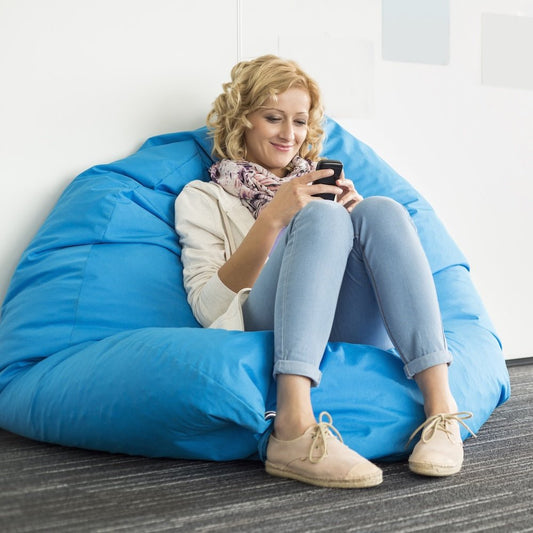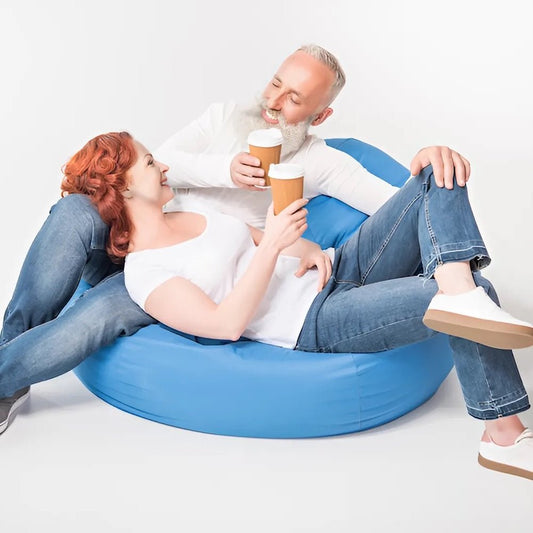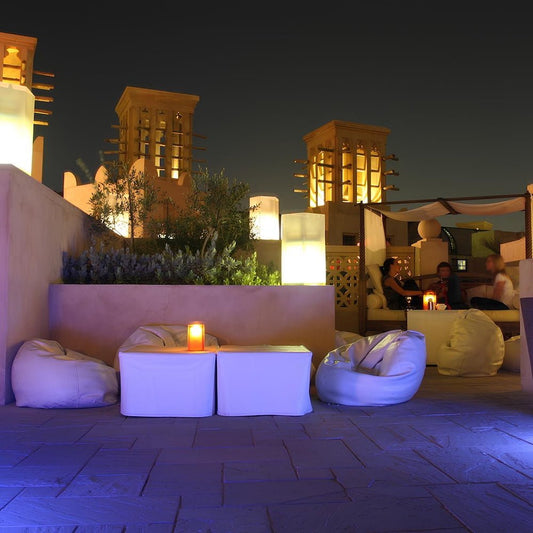If you're serious about your outdoor furniture, then you'll be hot on the trail of this relatively new fabric. Today we ask the question, what is olefin fabric? When it comes to pure production numbers, there's no denying that cotton is the world's most popular fabric. More than 29 million tons are produced each year. But that doesn't mean that cotton fabric is the best choice for every product. When it comes to fabric for outdoor, industrial, or other heavy-duty use, cotton is a poor choice. It's not stain- or water-resistant unless many byproducts are added. It's also far from durable. Instead, fabrics like nylon and polyester are better choices. Most consumers have heard of these fabrics. Although, there is another choice that beats them in terms of durability, stain and water resistance and comfort. That fabric is olefin. While it's widely used for a variety of products, few consumers know what it is. That's why we've created this guide to tell you what olefin is. We also tell you how it's produced, and why it's the superior choice. That's why we're using it in a variety of products. Keep reading to learn more!
What Is Olefin Fabric?
Olefin is a type of synthetic, or human-made fabric, that is derived from two chemicals. Those chemicals are ethylene and propylene, with propylene being the primary source.
The History of Olefin Fabric
The primary chemical used to produce olefin, propylene, is a by-product of oil production. This chemical was originally burnt off during the production process, as other uses for the chemical weren't known. However, in the mid-1900s, a new upcycling possibility was discovered. Olefin fabric was first created in Italy in 1957. Because the process used to produce olefin is relatively simple and does not require much machinery or tech, its use quickly spread. It can be produced by smaller companies, rather than solely by large corporations, which aided in its quick uptake in the industrial world. It would take just three short years before the production of olefin began in the United States.
How Is Olefin Produced?
The process used to produce olefin is a far cry from wool sheared from sheep or cotton grown, picked, and processed. Because olefin is derived from chemicals, producing it involves a complicated chemical process. To start, the chemicals used to produce olefin, including propylene and ethylene, are melted down. These chemicals require a temperature of between 110 degrees Celsius and 135 degrees Celsius to melt. Once they are melted, they are fed through a device known as a spinneret. A spinneret is a large device that looks similar to a showerhead. It contains small holes that the melted chemicals are forced through. The melted chemicals now form long fibres that are then allowed to dry. Once dry, they can then be woven into the fabric form of olefin that is used to create products like cushions and pillows. But before olefin can be used to produce consumer products, it needs to be dyed. Olefin fabric, once it is woven, is very tough to dye. Instead, the chemicals used to produce olefin are dyed long before they are made into fibres and woven. This is done by using a solution dye that is added directly to the chemicals before they are melted. Sometimes the solution dye is added while the chemicals are being melted down and mixed.
Benefits of Olefin Fabric
Ever since olefin fabric was first invented, it has seen widespread use in a variety of industries. This is not only because of its easy production but also the widespread benefits it has to offer. A few benefits of olefin include the following:
It's the Eco-Friendly Choice
One of the biggest benefits of olefin is how eco-friendly it is. Compared to cotton, which is grown, or wool, which is sheered from sheep, the chemical process used to create olefin may sound like the furthest thing from eco-friendly. But the reality is that the production process involves very little by-product. This means that the ingredients used to create the fabric are completely used. Nothing needs to be thrown away, recycled, or processed. Another reason why olefin is so eco-friendly is the ability to reuse the fabric. Once a product created from olefin is no longer needed, begins to tear, or has otherwise begun to wear out, it can be broken down, back to its original fibres. These fibres can then be rewoven to create brand new olefin fabric. In fact, olefin is so reusable that its fibres can be recycled and re-extruded up to 10 times before it is no longer usable.
Incredible Strength
The thick weave and strength of the chemical fibres used to make olefin allow it to be incredibly durable fabric. Compared to other, weaker natural fabrics or those with a loose weave, olefin can be used to create products that need to be tough. This includes things like outdoor rugs, automotive interior fabrics, and even wall coverings. The strength of olefin fabric also means that the products it is used to make can hold up to years of use. This makes it a great choice for products like outdoor bean bag chairs or patio cushions, especially in hotel environments where they see constant, heavy use.
It's Water-Resistant
Because the fibres found in olefin fabric are synthetic, they are incredibly moisture resistant. To start, they repel and wick moisture. This means that rather than allowing water to seep in, they cause droplets to pool and sit on the top of the fabric. This means that when it comes to cushions and pillows, water is pushed to the outside of the fabric, rather than being drawn into the interior where it would come into contact with less water-resistant materials like stuffing or batting. Because olefin fabric wicks moisture, it also dries very quickly when wet. It's not just plain old H2O that olefin can hold up to. It's also ideal for use around pools, as it is resistant to the effects that chlorine has on other fabrics.
Abrasion Resistant
Another side effect of the strength of olefin fabric is that it is resistant to abrasions and wear. This means that it won't easily puncture or wear out in high-use spots.
It's Resistant to Mould and Mildew
As we mentioned above, olefin wicks moisture away. This means that water and other liquids won't have a chance to make their way to the interior of a fabric product like pillows or cushions. And because olefin fabric dries very quickly, water doesn't have a chance to sit on the fabric for an extended period. Both of these two factors work together to create this next benefit: olefin fabric is resistant to both mould and mildew. Cotton and many other natural fabrics hold onto moisture and allow it to sit. If the fabric isn't then properly dried, mould or mildew will form. This will often ruin the products. Olefin eliminates this issue. This makes it ideal for use on products that may come into contact with water or moisture.
It's Stain Resistant
In the same way that liquids are wicked away from the surface of olefin fabric, it also repels stains. Even tough stains, like wine or oil, can often be cleaned away with ease when they land on products made from olefin.
Colour and Patterns Won't Fade
You already know that olefin fabrics are made to be heavy-duty and durable, as well as resistant to threats like mould, mildew, and moisture. But this isn't the only reason that products made from olefin last so long. As we mentioned previously, olefin is dyed while still in the production stage. The solution dye is added to the chemicals before or during the melting process. This means that colours are locked in tight. Once dyed and finished, the olefin fibres can be woven to create patterns. But whether you choose a solid coloured product made from olefin or a pattern, you'll get a fabric that won't dull or fade over time. Your products will stay sharp and bright for years to come, even if they are left in direct sunlight.
Easy to Clean
Because stains don't stick to the fabric and water runs right off of the fabric, olefin is very easy to clean. This makes it even more ideal for use in automobile interiors or on outdoor furniture, as it can stand up to spills and messes with ease. The only exception to this is oil-based stains. These may be difficult to clean from olefin fabric. Find out how to clean olefin fabric.
No Static-Charge
This isn't a benefit that most consumers consider when choosing fabric products. But if you hate the feeling of static cling when you slide across your patio furniture or upholstered furniture in a pair of shorts or a short dress, you'll love olefin. Olefin fabric does not transmit static charge.
What is Olefin Fabric Used for?
The many benefits of olefin mean that is used for a wide variety of purposes. One popular use in outdoor furniture. This includes outdoor patio furniture cushions, outdoor rugs, outdoor bean bag chairs, and throw pillows. The fabric's water resistance, stain resistance, and fade resistance mean that it can stand up to rain, dirt, and sunlight over time. Another popular use for olefin fabric is in automotive interiors. The fabric won't puncture or wear easily when passengers slide in and out of the car. Stains won't stick, and your seats will be easy to clean. Upholstery and wall-coverings can also be made from olefin. The patterns and colours won't fade in the light or wear in spots where people sit or frequently brush against them. Olefin is also used for a variety of industrial purposes. This includes use for filters, bags, and geotextiles.
What to Look for in an Olefin Fabric
Not all olefin fabrics are created equal. If you want to enjoy the many, many benefits of olefin materials, you'll want to choose a high-quality product. When you're shopping for olefin fabrics, make sure that you choose items with a tight weave. A loose weave may negate some of the fabric's benefits, like strength. Besides a tight weave, fabric that has been properly dyed is also a must. This will help ensure that it doesn't fade over time, losing it's bright, vibrant look. Another thing to consider when choosing a product made with the use of olefin is whether it is designed for outdoor use. Basic olefin fabric on its own is not designed for use outdoors. This means that bright colours and punchy patterns may quickly fade, as the fabric is quite sensitive to sunlight. However, olefin is incredibly popular for outdoor use. It is so easy to clean, lightweight, and resistant to bugs and mildew. All of these qualities make it ideal for outdoor use; except for its susceptibility to fading in the sun. For that reason, manufacturers have engineered new olefin fabric that is resistant to sunlight. All you have to do is ensure that you're choosing the right olefin fabric for your outdoor patio cushions, throw pillows, curtains, and other fabric products. Check the label or ask the manufacturer if the fabric is designed for outdoor use and is resistant to fading in the sun. The olefin fabric we use is more fade resistant than Sunbrella and will last for five years in sunlight. Beware of immitation products using Sunproof Olefin. Sunproof Olefin is a cheap inferior fabric that usually tears within 12 months.
Caring for Olefin Fabric
While olefin fabric is resistant to moisture, stains, mould, punctures, and more, that doesn't mean that it is completely maintenance-free. Olefin is great for use in many different environments, but it is also heat sensitive. You won't want to expose your fabric to extremely high temperatures or else it may melt. Most households won't run into this issue very often, but it is something to consider when olefin is used in industrial environments. One instance when you will want to be careful about the heat in your house is if you ever need to iron your olefin fabric. If you must use an iron, set it on the lowest temperature setting that you can. The second instance when you may find yourself accidentally exposing your olefin material to heat is in the wash. If you need to wash your olefin and dry it afterwards, set your dryer to tumble dry with gentle or no heat. If you can, it's best to hang the fabric to dry instead.
Choosing Your Olefin Products
Olefin is a great choice for everything from outdoor bean bags to automotive interiors. Durable and long-lasting, it will help you create bright, beautiful lounge spaces that you'll enjoy for years to come. Now that you know the best fabric to use, it's time to learn the other factors you'll want to consider when choosing products. Check out this post next to learn what you need to consider when choosing outdoor cushions.




